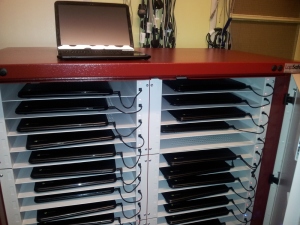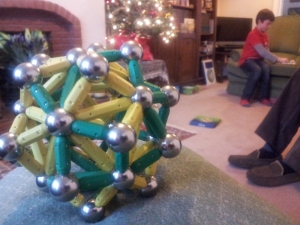@trulypinkthing always makes fantastic cakes for our meetings. Today we’re discussing how schools can use Facebook, Twitter and blogs.
Author: oldsteve
Chromebooks: faceless magnificence
It’s been some time since I added to my growing list of Chromebook posts.
- used Worpress to blog (on the Chromebooks);
- used Purple Mash to design 3D models (on the Chromebooks);
- used Google Maps to embed photos of the school as part of the Switched on ICT scheme of work (on the Chromebooks);
- used Google Docs to write stories (on the Chromebooks);
- used Google spreadsheets to learn their times tables (on the Chromebooks);
- used Khan Academy to practice maths skills (on the Chromebooks);
- used Education City to practice phonics and literacy skills (on the Chromebooks);
- used GoAnimate to make animations (on the Chromebooks);
- used Aviary to create their own music (on the Chromebooks).
- The 8 second start up means that the only time wasted is distributing the Chromebooks to the students, whereas the laptops could take up to 2 minutes to boot up and access the network.
- No virus checker means that the Chromebooks work fast from the start, whereas the laptops would be slowed by for ten minutes by the inevitable start up of various Windows processes.
- An 8 hour battery life in the Chromebooks means that they only need to be charged over night, whereas the laptops would have to be charged during lunchtime to give afternoon users a chance.
- The light weight of the Chromebook means you can carry them around the classroom to show other people what you’ve been up to, whereas our laptops had been much heavier.
- The VGA adaptor that comes with every Chromebook has been really useful for showing what’s on the screen on the classroom projector. The laptops by contrast often did bizarre things when connecting to a projector.
When shall we have Teachmeet Brum?
So I’m looking to organise a Teachmeet in Birmingham sometime in March.
What I learned from BETT 2012 #2: Grass isn’t always greener
I’ve never experienced a different education system than the British one, but of course the odd snippet or two has come my way over the years which have led me to the following beliefs about education in different countries:
- The district structure in the US is ideal with between 10 and 20 schools in each district.
- Hungarian education is best at teaching maths.
- Finland is perfect.
What I learned from BETT 2012 #1: Cloud is the new Interactive Whiteboard
Moments of learning from #domoreedu
My happiest moment of learning was sitting with my Year 4 teacher some 20 years ago and really ‘getting’ long multiplication. I remember thinking this is what I can do – I’ve never forgot the process or that moment.
My least happy moment of learning was realising what I thought was good practice was actually rubbish. It forced me to change quickly.
Welcome to my fully armed Lapsafe Chromebook trolley
It wouldn’t strike many to be that important, but over the next few weeks I reckon I’m going to be counting my blessings that I forked out for a top of the range trolley from Lapsafe.
Surely it’s the quality of the technology – the laptop, the iPad, the Chromebook – that’s important. Surely it’s the product support / the software / the training that is the key to succesful deployment.
Nope. I think it’s the quality if the charging trolley (or Cart if you’re US).
The next few weeks will prove me right or wrong.
“Wow – Purple Mash looks ace!”
Today was the first time that all the staff got their hand on the Chromebooks.
Cue the imposition of another fad in education
Many people who will have read the announcement from the Prince’s Trust I found on the BBC this morning will have dismissed it with the thought Oh anyone could have told you that. That’s just common sense. The headline reads, “Princes trust: school grades hit by lack of routine.” In the article, the vital statistic is that 30% of students with poor grades had no set routine as a child, contrasted with 14% of students with ‘better grades’.
Concerned minister: Have you seen this article? We need to bring back routines into family life.Junior minister: How can we do that? We don’t control every family.Concerned minister: Hmm. What do we control?Junior Minister [Thinks]Civil servant: There’s always schools. And Ofsted.Junior Minister: Yes. We could make schools teach their children to have better routines at home.Concerned Minister: Yes. It could be part of the criteria in the Ofsted framework.Civil servant: So… you’d like a glossy pack going out to every school, perhaps? An instructional DVD? A website?Concerned Minister: Yes, that sounds good. I could really… Oh I mean, this will help the whole country.Junior Minister: I’ll prepare a press release…Civil servant: Might you also like a pilot study? Some academic research to back up what we want to do?Concerned Minister [eyes glowing a baleful red]: Yes! Yes!Civil servant: Right away minister.
The King of shapes: the stellated icosahedron
There’s nothing quite as good as mathematical toys for Christmas. After I had wrested this ‘geomac’ off the children, I made my very favourite shape – the stellated icosahedron.
I just love adding points to a platonic solid.
With 60 faces, 90 edges and 32 vertices, Euler’s formula still holds true: 32+60-90=2 (vertices+faces-edges=2 for all solids without holes in them).
The question for young mathematicians is “do all the 3D shapes you know follow this rule?” and following on from this “can you make a 3D shape that doesn’t follow this rule?” [clue: try making a donut out of geomac].




